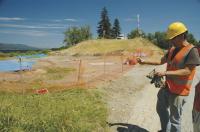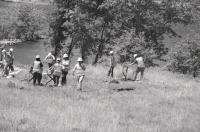
Serving the Vermont Champlain Valley Area for 45 Years
Main SectionsFront Page SportsValley VitalsIt's in the StarsStarwiseArchivesLinksAbout The VoiceContact Us |
Archeologists At Chimney Point Confirm Initial Findings On French Fort
Tuesday June 29, 2010 By Ed Barna It would be hard to say who is working harder, Flatiron Construction and its subcontractors building a new Champlain Bridge, or the archeologists trying to research terrain that will be excavated or covered by that project. As anyone who rides the free ferry to and from New York State will see, Flatiron ain’t flat. Gigantic cranes they have brought in will do much of the heavy lifting for putting up the new bridge. The voyage is worth recommending to visitors. Among the out-of-staters who have taken it was former Valley Voice reporter Damon Barna, now a resident of Minneapolis, who watched Flatiron replace a failed Interstate bridge that drew national attention to the dismal state of much of the nation’s infrastructure. “It went up very fast,” he said, confirming the observation of one construction industry official at a previous meeting that Flatiron had earned every possible incentive bonus in Minneapolis for beating deadlines. In turn, the bridge contractor’s progress is an incentive for urgency on the part of the UVM Consulting Archaeology Program, which has been tasked with researching the bridge site at Chimney Point. The Voice spoke with Mark Petersen, part of the UVM Historic Preservation program, who has assisted with surveying the ground and sifting the top layers for artifacts. Initial reports on the work at Chimney Point cited state archaeologist Giovanna Peebles as saying artifacts seemed to point to a 1731 French fort suspected to have existed there, but she said they needed more confirmation that it was indeed what documents from that era showed rather than a homestead. Petersen said that initial hypothesis has been confirmed beyond doubt. Findings have been “about as good as it gets for Vermont archaeology,” he said. Buttons from soldiers’ garments and musket balls were the most numerous, he said, with the most unusual item probably a piece of an ornate pipe. At one point, they found traces indicative of a large hearth, Petersen said. English artifacts have surfaced as well as French items, he said, since ultimately the English drove the French from the environs of the lake that French explorer Samuel de Champlain had named in 1609. Tarps now cover much of the ground that has been researched. The pits are within an area perhaps 100 feet across (the 30-man French fort was 100 by 125 feet), on a relatively flat bench that gives a very good view of traffic on the lake—a logical location for a fort. If the area between that site and New York State was expanded by filling during the 1929 construction of the Champlain Bridge—which seems plausible given the age of the trees there now—the fort and its cannon would have been even more prominent in its role as co-guardian (with Fort St. Frederick at what is now Crown Point) of the narrow point in the lake. A Flatiron superintendent informed the Voice that the area is a restricted hardhat zone. Being only hardheaded, this reporter left the scene—but not before learning from Petersen that Vermont archaeology has scored one of its major successes.
|
AdvertisementsSearch our Archives |
Agricultural Weather Forecast:

© 2006-18 The Valley Voice • 656 Exchange St., Middlebury, VT 05753 • 802-388-6366 • 802-388-6368 (fax)
Valleywides: [email protected] • Classifieds: [email protected] • Info: [email protected]


 Printer Friendly
Printer Friendly